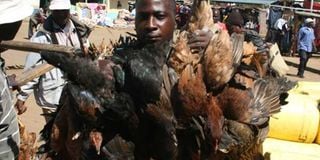Improve yields with new Kari ‘kienyeji’ chicken breed

A man selling kienyeji chicken at Kisumu market. PHOTO | JACOB OWITI | FILE
What you need to know:
- It took Kari 10 years to develop the bird after studying the strengths and weaknesses of different breeds
- A day-old chick of the new breed costs Sh100 at the Naivasha centre
Kenya Agricultural Research Foundation (Kari) has come up with a new breed of indigenous chicken that offers better yield.
The breed known as Kari Improved Kienyeji Chicken was developed after years of intensive research under the National Poultry Development Programme.
Kari’s senior researcher at Naivasha Poultry Development Institute Ann Wachira said the super breed develops faster, is highly resistant to diseases and has high productivity.
“This is a hen that achieves 1.5kg in about five months when the rest of the indigenous breeds take up to seven months or more,” she told Seeds of Gold.
“Its ability to withstand harsh conditions is amazing. The feathering system makes it adjust faster than the time taken by others to acclimatise with any climatic conditions, including the arid and semi-arid regions.”
It took Kari 10 years to develop the bird after studying the strengths and weaknesses of different breeds of indigenous chickens across the country.
“We went to several parts of the country including Turkana, picked chicken and brought them to our laboratories. We then studied them to establish their weaknesses and strengths and then interbred them to produce the best breed.”
A day-old chick of the new breed costs Sh100 at the Naivasha centre but farmers who don’t have brooders can buy four weeks old chicks at Sh250 each.
Before releasing them to farmers, the institute vaccinates the chickens from the deadly marecks disease and culls the weak ones to prevent them from going to the market. It also provides the farmers with a vaccination guideline.
The chicken is easy to maintain since it can be kept under the free range system or deep litter depending on a farmer’s financial ability and objectives.
Those who want them to mature faster or produce more eggs are advised to keep them in a semi-intensive or deep litter system. This way, the chickens don’t spend a lot of energy. Farmers have an option of keeping them as layers, for meat or both.
When fed with quality feeds available from accredited manufacturers, a hen can reach up to 1.5kg in five months and a cock weighs 2.1kg.
A fully grown kienyeji cockerel costs Sh1,000 while a hen costs Sh600. A hen can produce between 220 and 280 eggs a year. This is almost similar to a white leghorn exotic layer kept in a deep litter system.
With a tray of kienyeji eggs costing an average of Sh450, compared to exotic ones at Sh300, farmers who will keep kienyeji chicken as layers stand to make get good earnings.





